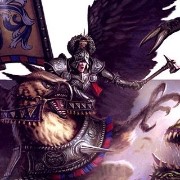|
i would be legit interested in histories of nazi germany from before the war though
|
|
|
|

|
| # ? May 11, 2024 14:19 |
|
HEY GAL posted:i would be legit interested in histories of nazi germany from before the war though The Coming of the Third Reich by Richard Evans is apparently very good. It's still sitting on my to-read pile though; I should really get around to reading it.
|
|
|
|
JcDent posted:Did they run the whole party on Croatian Dirlevangers? Because we know that gas chambers et al were made because even hardcore nazis couldn't bear killing so much people directly (by shooting), so how come these guys got even closer and dirtier, and didn't have any issues? You cannot expect these people not to have the same issues. The difference might be that the german leadership actually cared in one way or the other for the wellbeing of their men, even if it's in terms that you can't carry out the task with them being raving alcoholics, going insane or killing themselves in unacceptable numbers. The decision to move to other methods than shooting came after Himmler visited the Mogilev area in fall '41, he pulled the strings pretty fast after that to make other methods of extermination happen.
|
|
|
|
Endman posted:The Coming of the Third Reich by Richard Evans is apparently very good. It's still sitting on my to-read pile though; I should really get around to reading it.
|
|
|
|
HEY GAL posted:that is a history of the prewar period written after the fact, i'm talking about what an informed observer in 1935 thinks is going on Sorry I didn't grab all the books I mentioned (I just took the WWI book and Grant's Memoirs), although when I got back I will get some pictures of them and probably grab them
|
|
|
|
Fangz posted:What do people make of this article?
|
|
|
|
JaucheCharly posted:You cannot expect these people not to have the same issues. The difference might be that the german leadership actually cared in one way or the other for the wellbeing of their men, even if it's in terms that you can't carry out the task with them being raving alcoholics, going insane or killing themselves in unacceptable numbers. The decision to move to other methods than shooting came after Himmler visited the Mogilev area in fall '41, he pulled the strings pretty fast after that to make other methods of extermination happen. On the other hand, having a special knife to kill Serbs faster...
|
|
|
|
HEY GAL posted:that is a history of the prewar period written after the fact, i'm talking about what an informed observer in 1935 thinks is going on My grandmother somehow picked up a 1938 German tourist brochure in a jumble sale of all things. Lots of pictures of gymnastics and mountains. It's all very much in the predictable vein, even advertises Zeppelin rides, but pretty interesting. I'll see if I can dig it out next time I'm down there.
|
|
|
|
I just remembered that I did a D&D effort post years ago about a MilHist topic, but I'm not sure if I even knew that this thread was a thing back then, so I'm reposting it here because maybe you'll be interested and maybe you'll tell me the myriad ways in which I got it wrong  quote:
Also re: Nazis trippin' balls: Fangz posted:What do people make of this article? I skimmed the book this article is based on, and I wasn't exactly impressed tbh. While Ohler to my knowledge doesn't present anything factually wrong, he not only says nothing that wasn't known to experts beforehand but chooses to present it in a very sensationalistic way, complete with long more-or-less fictional passages thrown into the mix and bad puns like "Sieg High" and "High Hitler" aplenty. This isn't my main problem, though (trying to present historical stuff in a manner more accessible to non-historians is always good imo, even though in this case the book's become too "flippant" for my tastes) - instead it's his fixation on drugs being the main driving force behind pretty much everything the Nazis did that bothers me. He even claims that Hitler committed suicide because he couldn't cope with his drug supply being cut off, lol. But maybe I'm just too tainted by academia to enjoy any book with less than 5 footnotes per page, who knows
|
|
|
|
aphid_licker posted:I remember bewbies' armyposting. And Laissez Faire was loving magical. I had no idea what was going on most all of the time. Plenty of primo weirdos, wonder what dudes like Toblerone Triangular and Infrateal are doing now. A lot of dudes developed a highly specialized communications/worldview package in that forum that I don't think really translates into anything but yelling at passersby to stop gangstalking you. A few pages back, but Toblerone Triangular admitted they were a long con troll and not actually libertarian, and were giving up on that posting schtick because it was beginning to seep into their real life and affecting the way they thought in a bad way.
|
|
|
|
StashAugustine posted:Probably a controversial question, but how hard did the Axis minors (Hungary, Romania, Finland etc) buy into Nazism? Not very, iirc. Finland didn't give a poo poo about it at all.
|
|
|
|
HEY GAL posted:that is a history of the prewar period written after the fact, i'm talking about what an informed observer in 1935 thinks is going on You can find William Shirer's edited diaries online, I think. He published them shortly after America entered the war, and no doubt they were shaded with that in mind, but they're based on stuff he wrote down as a journalist in Berlin before the war. https://en.wikipedia.org/wiki/Berlin_Diary
|
|
|
|
MikeCrotch posted:A few pages back, but Toblerone Triangular admitted they were a long con troll and not actually libertarian, and were giving up on that posting schtick because it was beginning to seep into their real life and affecting the way they thought in a bad way. He who fights monsters etc
|
|
|
|
Jobbo_Fett posted:Not very, iirc. Finland didn't give a poo poo about it at all. But as posted above they were uniquely awful. Except possibly for Finland. Is there nothing bad to say about Finland? Clean Finn-magt?
|
|
|
|
HEY GAL posted:that is a history of the prewar period written after the fact, i'm talking about what an informed observer in 1935 thinks is going on I’ve read John Gunther’s Inside Europe, from 1936, which is full of reports and gossip.
|
|
|
|
So when ironclads and dreadnoughts started to take over from wooden battleships, what happened to all the wooden battleships? We must be talking thousands and thousands of ships. Scrapped for parts? How? Sunk for target practice?
|
|
|
|
Boiled Water posted:But as posted above they were uniquely awful. Except possibly for Finland. Is there nothing bad to say about Finland? Clean Finn-magt? I guess it depends on what you consider bad. Every third soviet POW in Finnish camps died of malnutrition and disease, which could be neglect or willful assholery, depending on circumstances. That said, they did execute around 1,000 of them. They had a bunch of governmental officials killed in show trials for crimes against soviet citizens, but that happened at the behest of the soviets and were likely kangaroo courts.
|
|
|
|
Boiled Water posted:But as posted above they were uniquely awful. Except possibly for Finland. Is there nothing bad to say about Finland? Clean Finn-magt? Swamp mongols?
|
|
|
|
JcDent posted:Swamp mongols? Are we making fun of finns now? As a Finnish dude told me in alcohol recovery: Once, I use to sit in hole in forest, with my knife and my vodka. Now, I sit in hole in forest, with my knife
|
|
|
|
Depressingly Swede-Adjacent
|
|
|
|
Thanqol posted:So when ironclads and dreadnoughts started to take over from wooden battleships, what happened to all the wooden battleships? We must be talking thousands and thousands of ships. Scrapped for parts? How? Sunk for target practice? It varies. It took a few decades for steam and iron to completely supplant wooden hulls and the large majority of wooden ships were simply broken up when they reached the end of their useful lives. Others got turned into floating accommodation or storage hulks. A half-dozen or so of the most famous were preserved as relics. In any case there were never thousands and thousands of wooden warships in existence at any one time. They constantly wore out and were replaced, so it wasn't as if there was a huge collection of 17th century ships of the line in reserve in the middle of the 1800s.
|
|
|
|
Thanqol posted:So when ironclads and dreadnoughts started to take over from wooden battleships, what happened to all the wooden battleships? We must be talking thousands and thousands of ships. Scrapped for parts? How? Sunk for target practice? The vast majority of warships that were ever built were not destroyed in battle, but eventually broken up. http://www.naval-history.net/WW1NavyBritish-Shipbreak.htm quote:Shipbreaking as an industry does not appear until a later date, but in Tudor days it was the regular practice to break up worn-out warships in the dockyards and to work all the material that was still serviceable into new hulls. The frequent shortages of seasoned timber, especially in wartime, made this practice necessary and it saved infinite trouble and labour with primitive tools in the making of new parts. Many of the ships so built, however, showed weakness from the first. Fangz fucked around with this message at 11:51 on Sep 26, 2016 |
|
|
|
Boiled Water posted:But as posted above they were uniquely awful. Except possibly for Finland. Is there nothing bad to say about Finland? Clean Finn-magt?
|
|
|
|
Siivola posted:Paging Kemper Boyd to the thread. I bet he has some quality dirt. Oula Silvennoinen discovered about ten years back that there was something called Einsatzgruppe Finnland and the Finnish authorities and military turned over unknown amounts of POW's to them, mostly Jewish ones. Finland also ran concentration camps for Soviet civilians in Eastern Karelia which had a terrible survival rate.
|
|
|
|
Kemper Boyd posted:Oula Silvennoinen discovered about ten years back that there was something called Einsatzgruppe Finnland and the Finnish authorities and military turned over unknown amounts of POW's to them, mostly Jewish ones. Finland also ran concentration camps for Soviet civilians in Eastern Karelia which had a terrible survival rate. Wasn't the Finnish government at the time generally a shitshow as well, and there were all sorts of privations and hardships for the ordinary people and soldiers (I mean, more so than usual in war). Or am I totally misremembering that?
|
|
|
|
ALL-PRO SEXMAN posted:It varies. It took a few decades for steam and iron to completely supplant wooden hulls and the large majority of wooden ships were simply broken up when they reached the end of their useful lives. Others got turned into floating accommodation or storage hulks. A half-dozen or so of the most famous were preserved as relics. HMS Victory is a pro visit if you happen to be near Portsmouth, along these lines. The oldest commissioned warship in the world
|
|
|
|
feedmegin posted:HMS Victory is a pro visit if you happen to be near Portsmouth, along these lines. The oldest commissioned warship in the world wait, do none of those rad war galleys survive? hosed up if true
|
|
|
|
MikeCrotch posted:Wasn't the Finnish government at the time generally a shitshow as well, and there were all sorts of privations and hardships for the ordinary people and soldiers (I mean, more so than usual in war). Or am I totally misremembering that? Not as much as a shitshow, but the govt mostly ruled by decree during the duration of WW2 and the parliament got entirely sidelined until the peace opposition got big enough. Otherwise, privations and hardships were mostly the same poo poo you'd see anywhere else in Europe, i.e. rationing and all that. Finnish pre-WW2 govt in general can be characterized by being irresponsible as poo poo when it comes to relations with the Soviets because for all his poo poo, Stalin was absolutely right about Finland being an unreliable neighbor. .
|
|
|
|
There's a book on Kennedy's travels in Germany pre- and immediately postwar. It uses/reproduces letters and diary entries but some of the reviews say that it seems padded and short on the actual source material. Haven't read it so idk. Unter Deutschen: Reisetagebücher und Briefe 1937-1945 von Prof. Dr. Oliver Lubrich (Herausgeber), John F. Kennedy (Autor) MikeCrotch posted:A few pages back, but Toblerone Triangular admitted they were a long con troll and not actually libertarian, and were giving up on that posting schtick because it was beginning to seep into their real life and affecting the way they thought in a bad way. Yeah he did a post on his technique for making his posts that was pretty amazing. Unless I'm confusing him with someone (entirely possible) the thing wasn't so much the libertarianism but the very convincing insanity. He came up with purestrain gold iirc.
|
|
|
|
Link to said post pls?
|
|
|
|
Empress Theonora posted:Wait, what? https://www.youtube.com/watch?v=_lSR--KULac Said band of FRG-boos launched a concerted witchhunt campaign against me because I had math that showed that their infantry was actually way above average. But for them, any thread that was negative about the balance of their beloved kruppsthal, they would come in and threadshit with willful misinformation and accusations of bias and so forth. Even now, they are still salty about me. What's funny is that all the things that I pointed out as good changes to be made eventually came to pass anyway 
|
|
|
|
Boiled Water posted:But as posted above they were uniquely awful. Except possibly for Finland. Is there nothing bad to say about Finland? Clean Finn-magt? A lot of soviets died in camps but AFAIK the Finns themselves were also starving during the war, so how much of that's malice I'm not sure. e;fb, post is not refresh edit: Googling it seems that, even if the famine wasn't intentional, which is quite contested, the Finns were brutal to the prisoners, including women and children. spectralent fucked around with this message at 12:29 on Sep 26, 2016 |
|
|
|
The most sad Axis country was Yugoslavia. Yugoslavia had been ruled by a fellow known as Prince Paul. He was never supposed to be even close to any real power and spent most of his adult life in Britain. He was educated at Oxford and spent most of his time going to parties, collecting art, and just living the life of a pre-WW2 rich British person. Then Yugoslav King Alexander gets assassinated in Marseilles and Paul's whole world changed. He went back home to run the country as Regent for Alexander's son Peter. This was something he genuinely did not want to do. However, he surprised everybody by not horribly sucking at the job. Actually he pushed forward some real reforms. Even gave most of his artwork to the Yugoslav people. The real problem that Yugoslavia had had since independence was Croatia. The Croats wanted independence and were pissed off at being ruled as part of a multi-ethnic state essentially dominated by a Serbian monarchical dictatorship. Paul worked towards a solution for years and finally presided over an historic agreement, his greatest achievement, that kept Yugoslavia together, that probably could have lasted forever, where the Croats got everything they wanted except independence. Unfortunately, this was 1939. With the coming of the war Paul tried his best to be neutral, even though he really really really loved the UK. What happened between 1939 is complicated, but it boils down to this: Hitler put ever-increasing and unceasing pressure on Prince Paul to sign the Tripartite Pact and become a formal member of the Axis. He just kept putting Hitler off and delaying endlessly while watching Nazi armies crush Europe and all his neighbors join the Axis. Finally, in the spring of 1941, surrounded and with very little choice, Paul gave in. Hitler did this thing where he'd force foreign leaders to come to Berlin and yell at them a lot till they did what he told them to. This was no joke. The Czech Prime Minister had a heart attack during this process and then signed his whole country away, for example. However, Paul got some pretty decent concessions. Yugoslavia would not declare war on the United Kingdom or anybody else. Yugoslavia would not provide any military support to the other Axis nations. Yugoslavia would not allow any Axis troops to cross through it. Yugoslavia would be a member of the Axis but not really do anything at all. This was a pretty good deal! Immediately though there were huge protests against Paul for signing the Pact and pretty speedily he was deposed in a coup largely orchestrated by British intelligence. Young King Peter was declared old enough and Prince Paul got dragged away to Kenya by British agents to live out the rest of the war in exiled imprisonment. Even after, he was not allowed to go back to Yugoslavia, or even the UK, and lived out the rest of his life pretty miserable in Paris. Churchill particularly hated the gently caress out of Prince Paul for his supposed betrayal. 10 days after the coup the Germans launch Operation Retribution, a very brutal bombing of Belgrade that starts off their invasion of the country. Yugoslavia falls, then is dismantled and goes through some of the worst miseries of a miserable war. A legend starts even during the war that the invasion of Yugoslavia delayed the invasion of the Soviet Union that summer just enough that it failed, and therefore all of Yugoslavia's agony was worth it for the greater good. This has pretty conclusively proven to be bullshit.
|
|
|
|
I suppose "not evil" was a little bit of an oversimplification about Finland, but so were all my characterizations in that post, I was summing up some very complicated issues as simply as I possibly could. Finland only cared about FInland. Mainly, staying independent and doing the best for Finnish people. Non-Finnish people or countries that weren't FInland didn't really matter. I'd call the Finnish state in WW2 a "quarereacracy", a word I just made up that means "rule by self-interest". It's an absolute miracle they survived the first Soviet invasion which everybody knew was wrong. The Western powers almost thought about kind of actually sort of giving them some kind of help but then didn't do anything, which is true. They had one real helping hand extended to them and they took it and they compromised themselves forever with this decision. They paid for their sins with territorial losses, the Lapland War, endless reparations, and always being known as a willing ally of Nazi Germany. Those are real consequences.
|
|
|
|
Thanqol posted:So when ironclads and dreadnoughts started to take over from wooden battleships, what happened to all the wooden battleships? We must be talking thousands and thousands of ships. Scrapped for parts? How? Sunk for target practice? This is going to be a very Royal Navy-centric post, but the same applied to nearly all the other major navies of the time. Just to get a handle on the numbers, in 1860 the Royal Navy had 398 ships on its books, of which 163 were in commission. The French Navy at the time had 142 ships on active service. Of the RN's strength 92 were sailing ships, including 27 ships of the line and 37 frigates. Only one of the frigates is listed as being in active service, with 8 being on 'harbour service' and 28 laid up 'in ordinary'. As to what happened to the wooden sailing ships as they were rendered obsolete, most were gradually demoted from active service to harbour service, then they were hulked and then they were broken up. These ships were still very useful long after they were completely obsolete as fighting vessels. The RN in particular had relatively little onshore infrastructure. Partly this was due to funding (the Navy was funded to operate ships, not buildings), partly due to tradition and a lot due to operating practise: Sailors are supposed to be on ships and it's easiest to maintain routine, discipline and security if as much of your personnel are kept on ships rather than ashore. So old and obsolete ships would be maintained on harbour service - still 'operational' but not equipped or intended to ever go to sea. These ships acted as the literal flagship of Port Admirals, squadron commanders-in-chief etc. Others would be hulked (all their masts and rigging removed, and often with a full-length roof built over the deck) and used as barracks, hospitals, prisons, stores and so on; almost anything that would now be carried out in a proper building ashore. Incidentally, this is what had been done with old ships for hundreds of years, not just because of the sail/steam transition. It's just that in this period there were a lot of obsolete ships and at the same time the Navy was growing in the amount of on-shore activity it needed to support itself. For instance, it was around this time that the RN began to formalise its training regimes for ratings and officers, rather than it being almost entirely through experience at sea. And harbour-bound ships of the line made ideal training platforms. Old ships were spread around ports and harbours to serve as basic training centres and when the Royal Naval Reserve was formed in 1859 a lot of the local units used an old sailing ship as a drill ship. Some of these ships lasted many, many times longer in 'retirement' than they did in active service. To take a famous example, HMS Temeraire (subject of the JMW Turner painting) was launched in 1798 and passed into reserve in 1812. She then existed as a prison ship, a receiving ship, flagship of the Medway Reserve Fleet and a training ship until she was broken up in 1838. That was fairly typical but some of the 'wooden walls' lasted a whole lot longer. HMS Nile, launched in 1839, was used by the RN until 1876 (having been converted to auxiliary steam power) and was then loaned to a civilian sea training association who used her until 1953 when she ran aground. HMS Implacable (1809) was hulked in 1850 and used as a training ship until she was scuttled in 1949 (she was the last seventy-four in RN service). HMS Wellesley (a seventy-four launched in 1815) was the port flagship at Chatham from 1854 until 1940, when she became the only ship of the line to be sunk in an air strike. Although not a wooden ship, HMS Warrior (1860) was in RN service until 1978, having been hulked in 1901 and ended her service as a fuel barge before being restored. The handful of wooden sailing warships that survive are almost entirely due to this habit of keeping them around in some form for decades, rather than any sentimental or historical feeling. As well as Warrior, Trincomalee was used as a training and accomodation ship until 1986 and even Nelson's Victory was scheduled to be broken up in 1831, having been used as a humble depot ship since 1812. After her reprieve she became a signal school and the nominal flagship of the Second Sea Lord. Since being put in dry dock in the 1920s she's still in 'active' comission, now as the flagship of the First Sea Lord. The RN still operates its shore bases as if they were comissioned ships ('stone frigates') and many of them take their names from the hulked ships of the line that were their original home. The training school at Portsmouth is HMS Excellent, after the original seventy-four which was anchored in the upper reaches of the harbour for gunnery training in the 1830s. The naval college at Dartmouth is HMS Britannia since that's the static ship that was originally moored there in the 1850s. And the RN still uses old warships this way - HMS Bristol, retired in 1987, is 'hulked' at Portsmouth as a training and accomodation ship.
|
|
|
|
System Metternich posted:I just remembered that I did a D&D effort post years ago about a MilHist topic, but I'm not sure if I even knew that this thread was a thing back then, so I'm reposting it here because maybe you'll be interested and maybe you'll tell me the myriad ways in which I got it wrong  Holy poo poo, the siege of Candia was brutal. Holy poo poo, the siege of Candia was brutal.
|
|
|
|
cheerfullydrab posted:They paid for their sins with . . . always being known as a willing ally of Nazi Germany. Those are real consequences. Basically all I've ever seen people say about Finland in WWII is some variation of "woo Simo Häyhä, rah rah, gently caress the Soviets". Some people even idolize Lauri "Larry Thorne" Törni without pausing to think about how he volunteered for the SS in the middle of the Lapland War.
|
|
|
|
What was going on with Hungary's peace deal? I'd forgotten about that.
|
|
|
|
HEY GAL posted:wait, do none of those rad war galleys survive? hosed up if true I don't know about that, but I said 'commissioned', i.e. it's still officially in Royal Navy service with a captain and crew and all that. 
|
|
|
|

|
| # ? May 11, 2024 14:19 |
|
Boiled Water posted:But as posted above they were uniquely awful. Except possibly for Finland. Is there nothing bad to say about Finland? Clean Finn-magt? I kind of got the impression that Finland mostly wanted to fight the Soviets and didn't give a poo poo about much else. Or at least they didn't get a lot of chance to care about much else given that fighting the Soviets was what they spent most of the war doing.
|
|
|










































